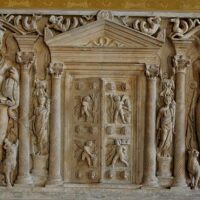Cardea : Goddess of Hinges
Listen
At a glance
| Description | |
|---|---|
| Origin | Roman Mythology |
| Classification | Gods |
| Family Members | N/A |
| Region | Italy |
| Associated With | Doors and Hinges |
Cardea
Introduction
Cardea is a lesser-known yet pivotal figure in Roman mythology, revered as the goddess of door hinges and the protector of households. Her role extends beyond these everyday objects, symbolizing the transition between spaces and safeguarding homes from malevolent spirits. Cardea’s significance is further highlighted by her connection with Janus, the god of doorways, as she embodies the protection of both physical and metaphorical thresholds, representing the passage from the past to the future. Although not as prominent as other Roman deities, Cardea’s influence in ensuring the sanctity and security of the home made her an important figure in ancient Roman beliefs. Her name, derived from the Latin “cardo” meaning “hinge,” underscores her association with these vital architectural elements.
Physical Traits
Cardea’s physical descriptions are minimal, with few details available in classical sources. She is often envisioned with dark hair and eyes, similar to her daughter Claudia, and these traits align with her role as a nurturing and protective deity in Roman mythology. While her artistic depictions are rare, she is typically portrayed as a serene, maternal figure, possibly clad in a simple gown or robe. Symbols such as keys and locks frequently accompany her imagery, underscoring her connection to doorways and thresholds. These symbols not only highlight her role as a guardian but also emphasize her association with Janus, the god of transitions. Cardea’s representation in Roman art and literature focuses more on the symbolic objects linked to her domain rather than specific physical attributes, reflecting her responsibilities as a protector of homes and secrets.
Family
Cardea’s familial ties in Roman mythology are intriguing yet not entirely clear. Some sources suggest she might be the daughter of Janus, the god of beginnings and doorways, which aligns with her role as the protector of thresholds. This connection underscores the symbolic relationship between their domains, emphasizing the harmony between past, present, and future. In other accounts, Cardea is linked to Juno, the queen of the gods and protector of the home, further reinforcing her role as a guardian of domestic spaces. The idea that her father was a Roman Centurion adds a layer of authority and strength to her background, symbolizing the need for protection within the household. Beyond mythology, the name Cardea has persisted into modern times, influencing personal histories such as that of Frank Cardea, demonstrating the lasting impact of her legacy.
Other names
In Roman mythology, Cardea is occasionally known as Carda, a name derived from “cardo,” meaning pivot or hinge, highlighting her role in overseeing doorways and transitions. This name variation may reflect regional dialects or textual adaptations. Another name associated with Cardea is Carmenta, an Etruscan designation adopted by the Romans. Carmenta was linked to childbirth and prophecy, hinting at a connection between Cardea’s protective role and the safe arrival of newborns. Additionally, Cardea is sometimes merged with the goddess Carna, mentioned by the Augustan poet Ovid. Carna, celebrated on the Kalends of June, was associated with health and the safeguarding of children from witches. This blending of Cardea with Carna in Ovid’s writings may indicate overlapping traditions or shared attributes between the deities.
Powers and Abilities
Cardea’s notable powers center around her role as a protective deity, particularly in safeguarding homes from supernatural threats. Her dominion over hinges and thresholds symbolizes her control over entry points, allowing her to prevent evil spirits and intruders from entering. This protective function is especially focused on ensuring the safety of children, often involving the use of magical substances like hawthorn to ward off danger. The saying attributed to her, “Her power is to open what is shut; to shut what is open,” underscores her influence over transitions and boundaries. Though her powers are more specialized compared to major deities, Cardea’s role in protecting doorways and ensuring safety was highly valued in daily Roman life. Her ability to guard both physical spaces and metaphorical transitions highlights her importance in providing security and comfort.
Modern Day Influence
Cardea’s legacy persists in modern culture through various forms of literature, art, and discussions of mythology. Her role as a guardian of the family continues to inspire contemporary creators who explore themes of safety and transitions. In artistic representations, Cardea’s imagery as a protector of thresholds provides a rich source of inspiration for exploring the significance of home and the idea of safeguarding loved ones.
Her associations with health and wellness align with current narratives about family and domestic life. Cultural practices, such as the traditional meal of pork and beans on June 1st, serve as historical reminders of her protective role. The exploration of Cardea’s figure in spiritual and metaphysical discussions reflects her enduring relevance, offering new interpretations and applications in modern contexts.
Cardea’s influence also extends to contemporary storytelling and design, where the symbolism of doorways and hinges embodies greater meanings of protection and stability. Her role as a guardian resonates with modern themes of safeguarding spaces and ensuring security. Although her worship has diminished, the concept of protecting thresholds and homes from negative forces remains a recurring motif in various belief systems. Cardea’s mythological legacy, including her connection to Janus and the notion of duality, continues to be relevant in literature and popular culture, underscoring the timeless nature of her role as a guardian of transitions and sacred spaces.
Related Images
Frequently Asked Questions
What is lorem Ipsum?
I am text block. Click edit button to change this text. Lorem ipsum dolor sit amet, consectetur adipiscing elit. Ut elit tellus, luctus nec ullamcorper mattis, pulvinar dapibus leo.
What is lorem Ipsum?
I am text block. Click edit button to change this text. Lorem ipsum dolor sit amet, consectetur adipiscing elit. Ut elit tellus, luctus nec ullamcorper mattis, pulvinar dapibus leo.
What is lorem Ipsum?
I am text block. Click edit button to change this text. Lorem ipsum dolor sit amet, consectetur adipiscing elit. Ut elit tellus, luctus nec ullamcorper mattis, pulvinar dapibus leo.
What is lorem Ipsum?
I am text block. Click edit button to change this text. Lorem ipsum dolor sit amet, consectetur adipiscing elit. Ut elit tellus, luctus nec ullamcorper mattis, pulvinar dapibus leo.
What is lorem Ipsum?
I am text block. Click edit button to change this text. Lorem ipsum dolor sit amet, consectetur adipiscing elit. Ut elit tellus, luctus nec ullamcorper mattis, pulvinar dapibus leo.











